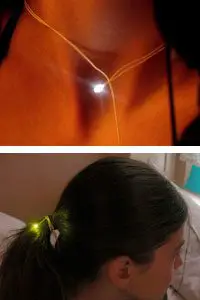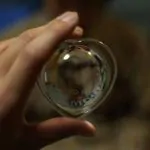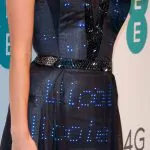What do solar panels and women’s fashion have in common? For the most part, pretty much nothing, except for the Day for Night Dress designed by Studio 5050 designers Despina Papadopoulos & Jesse Lackey. Studio5050 is well known for their sometimes off the wall wearable tech, but the Day for Night Dress is definitely something that could catch on if they ever decided to produce it to sell.
%22%20transform%3D%22translate(.8%20.8)%20scale(1.5625)%22%20fill-opacity%3D%22.5%22%3E%3Cellipse%20fill%3D%22%23817075%22%20rx%3D%221%22%20ry%3D%221%22%20transform%3D%22matrix(19.18607%20154.11665%20-41.98534%205.22678%20108%20172)%22%2F%3E%3Cellipse%20fill%3D%22%23fbffff%22%20cy%3D%2233%22%20rx%3D%2277%22%20ry%3D%2277%22%2F%3E%3Cellipse%20fill%3D%22%23fff%22%20rx%3D%221%22%20ry%3D%221%22%20transform%3D%22rotate(76.4%2037.5%20143.3)%20scale(168%2029.18153)%22%2F%3E%3Cellipse%20fill%3D%22%23fff%22%20rx%3D%221%22%20ry%3D%221%22%20transform%3D%22rotate(-79.6%2098.5%2067.3)%20scale(51.92523%2029.4027)%22%2F%3E%3Cellipse%20fill%3D%22%23bd454c%22%20rx%3D%221%22%20ry%3D%221%22%20transform%3D%22matrix(12.1421%20-27.40022%2042.96941%2019.04142%20167.8%20238.5)%22%2F%3E%3Cellipse%20fill%3D%22%23606a68%22%20rx%3D%221%22%20ry%3D%221%22%20transform%3D%22matrix(16.14682%20-55.02727%2017.16359%205.03636%2093.9%2065.3)%22%2F%3E%3Cellipse%20fill%3D%22%23fdffff%22%20rx%3D%221%22%20ry%3D%221%22%20transform%3D%22matrix(39.61185%202.284%20-.9485%2016.44996%2022.4%20246.6)%22%2F%3E%3Cellipse%20fill%3D%22%23fff%22%20rx%3D%221%22%20ry%3D%221%22%20transform%3D%22matrix(18.47909%20-8.30873%2024.7944%2055.14415%20168%2037.6)%22%2F%3E%3Cellipse%20fill%3D%22%23e36d97%22%20cx%3D%22103%22%20cy%3D%22248%22%20rx%3D%2233%22%20ry%3D%2219%22%2F%3E%3Cellipse%20fill%3D%22%237c7f7e%22%20rx%3D%221%22%20ry%3D%221%22%20transform%3D%22matrix(23.94438%2021.33366%20-22.86936%2025.66801%2080.5%2086.1)%22%2F%3E%3Cellipse%20fill%3D%22%23b0b3b3%22%20rx%3D%221%22%20ry%3D%221%22%20transform%3D%22matrix(110.8146%2027.5717%20-8.16589%2032.81988%20152%20180.7)%22%2F%3E%3Cpath%20fill%3D%22%23a47113%22%20d%3D%22M143%20236h26v20h-26z%22%2F%3E%3Cellipse%20fill%3D%22%23fff%22%20rx%3D%221%22%20ry%3D%221%22%20transform%3D%22matrix(10.89013%20-1.87877%202.95344%2017.11941%206%20163.9)%22%2F%3E%3C%2Fg%3E%3C%2Fsvg%3E) How it Works
How it Works
The Day for Night Dress that was created as a model was made using 436 white circuit boards linked together with rings. A modest user, or one who doesn’t want to use the dress as a tunic might want it to be a little longer as this one is quite short. Solar cells embedded on the circuit boards are used to collect energy during the day, and each one is moddable and controllable via the control on the back of the dress. There are a total of 448 cells on the dress pictured, although Studio 5050 never announced just how much power the dress can conduct. From there, the built in USB connector allows the dress to be used to charge a phone battery, and plenty of other things that require power.
The dress can also be completely reprogrammed via the USB board, or via the RF transmitter that goes along with it.
Anyone who gets bored of the dress, wants to be a little flashier, or doesn’t need to charge their phone can also swap out some of the solar panels for anything from LED lights to photocells which run off of the power created by the dress.
Technology Behind the Day for Night Dress

The Day for Night Dress was designed in tribute to Paco Rabanne as a celebration of the beauty of electronics, but what is really beautiful is the technology that goes into this solar dress. The main system used to create the dress is known as ChainMail, a scalable electronics sensate skin which was originally designed as a sensor network. Built from 1×1†rigid circuit boards and flexible interconnections so that the ChainMail can be wrapped easily around any object, the material is versatile and useful. Each circuit board features thirteen sensors and an embedded processor. For the Day-To-Night Dress, these sensors were simply replaced with solar panels.
The Future of Solar Wear
While the idea of electrical clothing is extremely popular right now, with everything from phone charging sneakers to electric charging clothing hitting the news, it isn’t likely that this solar powered dress will ever become anything more than a fashion stunt. The dress is a brilliant idea but seeing as it was designed in 2006, is unfortunately not going anywhere.
What do you think? Would you wear a dress made out of solar panels? You can visit Studio 5050 at their website to see the Day-For-Night dress, and any of their other wearable tech creations.






























